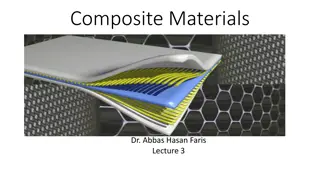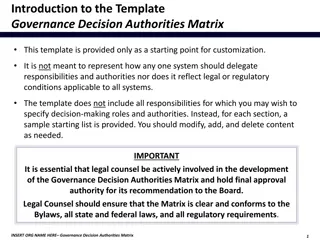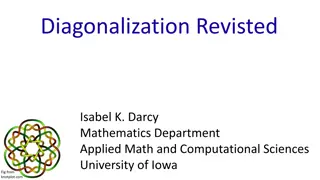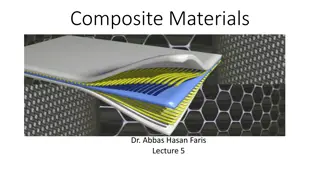
Understanding Matrices: Types, Operations, and Properties
Explore the world of matrices - from defining what a matrix is to understanding different types like triangular, diagonal, and identity matrices. Learn about operations such as addition, subtraction, scalar multiplication, and matrix multiplication. Discover the significance of singular and non-singular matrices, as well as the concept of transposing matrices.
Download Presentation

Please find below an Image/Link to download the presentation.
The content on the website is provided AS IS for your information and personal use only. It may not be sold, licensed, or shared on other websites without obtaining consent from the author. If you encounter any issues during the download, it is possible that the publisher has removed the file from their server.
You are allowed to download the files provided on this website for personal or commercial use, subject to the condition that they are used lawfully. All files are the property of their respective owners.
The content on the website is provided AS IS for your information and personal use only. It may not be sold, licensed, or shared on other websites without obtaining consent from the author.
E N D
Presentation Transcript
Definition A matrix is a rectangular array of numbers arranged in m horizontal rows and n vertical columns : is a mxn matrix (m rows, n columns), where the entry in the ithrow and jthcolumn is aij. We often write A=[aij].
Let Then A is 2x3 with a12= 2 and a23= 6 Let Then we knows that : a = 1, b =2, c = 3, d = 4, e = 5, and f = 6
Two m x n matrices A=[aij] and B=[bij] are said to be equal if aij= bij, If Then A = B if and only if x = -3, y = 0, and z = 6
Types of Matrices Triangular matrices A matrix like this one, with all-zero entries below the top-left-to-lower-right diagonal ("the diagonal") is called "upper triangular". Diagonal Matrices A matrix with non-zero entries only on the diagonal is called "diagonal
Identity Matrices A diagonal matrix whose non-zero entries are all 1's is called an "identity" matrix
Singular Matrices : determinants = 0 Non Singular Matrices : determinants 0
Matrix Addition . We need to add the pairs of entries, and then simplify for the final answer :
Matrix Subtraction Given the following matrices, find A B and A C, or explain why you can not. A and B are the same size, each being 2 3 matrices, so I can subtract, working entry-wise :
However, A and C are not the same size, since A is 2 3 and C is 2 2. So this subtraction is not defined.
Scalar and Matrix Multiplication There are two types of multiplication for matrices: scalar multiplicationand matrix multiplication. Scalar multiplication is easy. You just take a regular number (called a "scalar") and multiply it on every entry in the matrix. Let
Scalar Multiplication For the following matrix A, find 2A and 1A. To do the first scalar multiplication to find 2A, We just multiplya 2 on everyentry in the matrix :
Matrix Multiplication Find CD and DC, if they exist, given that C and D are the following matrices : C is a 3 2 matrix and D is a 2 4 matrix, so first I'll look at the dimension product for CD :
So the product CD is defined (that is, We can do the multiplication); Here's the multiplication:
Determinants If you have a square matrix, its determinant is written by taking the same grid of numbers and putting them inside absolute-value bars instead of square brackets : M2x2 : Ma3x3 : = a.e.i + b.f.g + c.d.h b.d.i a.f.h c.e.g
Inverse If you are given a matrix equation like AX = C, where you are given A and C and are told to figure out X, you would like to "divide off" the matrix A. But you can't do division with matrices. On the other hand, what if you could find the inverseof A, The inverse of A, written as "A 1" and pronounced "A inverse", would allow you to cancel off the A from the matrix equationand then solve for X.
We know that : A x A-1= A-1x A = I , Assume that :
AX = C A 1AX = A 1C IX = A 1C X = A 1C Note : Multiplying by the identity matrix I doesn't change anything, just like multiplying a number by 1 doesn't change anything.
Let A, B and C are matrices, then A + B = B + A AB BA AI = IA = A AA-1 = A-1A = I A + (B + C) = (A + B) + C A (BC) = (AB) C A (B + C) = AB + AC
Homework Suppose we know that : 1. Define : a) A+B 2. Prove that : a) (AB)C = A(BC) b) IBA = BA b) A B - C c) AB






















